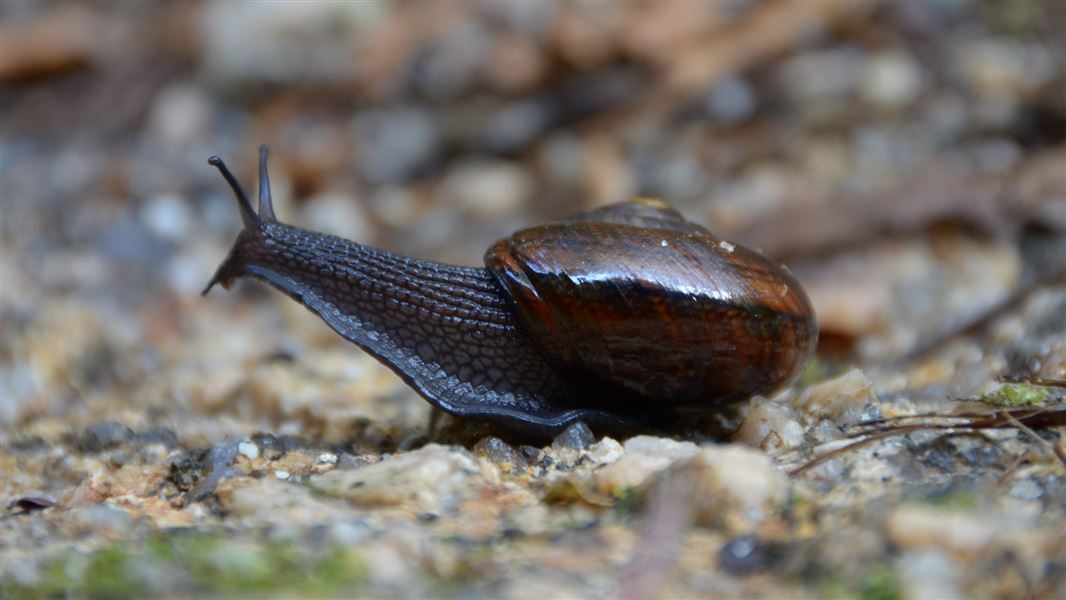Archived content: This media release was accurate on the date of publication.
Date: 17 April 2020
1400 rare Powelliphanta augusta snails live in refrigerated containers, on beds of moss, and are fed 4-6 worms a month by DOC rangers working in isolation. These snails are unique in that they are carnivorous, unlike garden snails in New Zealand which are an introduced species and eat foliage.
As well as being fed, the bedding material for the snails is changed, snails are measured and weighed, and the worm farm which feeds the snails is maintained. This work is essential to the health and wellbeing of this unique population.
The snails were taken into captivity after an extensive and detailed search during 2006-07 because the majority of their habitat on the Stockton Plateau was to be mined.
There are 16 Powelliphanta snail species in New Zealand and 57 subspecies, and they have each evolved quite separately and adapted to the environmental conditions where they are found – this means they are sensitive to changes in elevation, temperature, rainfall and forest composition.
Nicole Kunzmann, DOC Hokitika District Operations Manager says, “We have learnt a lot about these snails over the years and are breeding them successfully. Whilst we are releasing the offspring and eggs of these snails regularly, we are not yet comfortable to release the entire captive population.
“Everything about these snails happens slowly, including breeding, and they can live to be up to 20 years of age. Whilst we are monitoring wild populations of these snails with a view to release them all in time, we don’t yet have enough information to be satisfied that the areas where transferred snails have been established in the wild will be suitable for them in the long term.”
Most of DOC’s work with wildlife is on hold while the country is under alert level 4 unless it’s essential to deal with a significant hazard to public health and safety.
On hold work includes non-essential work with wildlife such as monitoring species in the field, monitoring pests, deploying technology like cameras, weed control, checking traps and undertaking predator control operations.
DOC will continue essential care for animals such as kaki/black stilt, takahe and other species held in captive facilities provided this can be done in a way that is safe for staff and meets requirements for minimal contact under Alert Level 4.
Conservation institutes and facilities looking after native species on behalf of DOC can also continue essential care of wildlife provided they meet the government’s criteria for essential work under Alert Level 4.
Background information
6000 snails were taken from the Stockton Plateau in 2006-2007. 4000 of these snails were translocated shortly after capture to new sites on the Mt Augustus ridgeline, just to the north of their original range and Mt Rochfort 15km to the south.
DOC has managed a captive population of the snails since 2007, and during that time their population has greatly increased, as they live in closely monitored conditions, are well-fed, and are not subject to any predation (from both introduced and native predators).
DOC has learnt a lot about the snails since they have been in captivity and finding out how to best look after them was an important focus of the captive programme in the early days. Although we knew about the habitat they came from, we knew very little about how being in captivity would affect them, for example, how fussy they would be with what they ate or if they would breed.
In comparison to other species that we manage in captivity, such as kiwi, they have proven to be relatively easy keepers – we provide a clean damp sphagnum moss and leaf litter house and four to six worms a month.
We are very pleased with the results of our captive programme. The overall picture is that from an initial 6000 snails collected, we have released around 7800 snails and 2800 eggs, with 1400 snails and 1000 eggs still in captivity.
About 150 of the original snails still remain in captivity.
Snails are slow-moving, slow-growing and slow breeding so getting information about how they adapt to new environments and situations takes a long time. Snails are eight years old before they breed, and each egg laid takes between 300-400 days to hatch.
Snails are slow-growing and don’t reach maturity until they are eight years old. Some of the snails are around 20 years old, we think from some of the sizes of the shells we have found that they may live to be 25.
Contact
For media enquiries contact:
Email: media@doc.govt.nz
